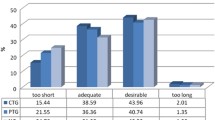Abstract
Aim
The aim of the present study was to investigate the assessment of currently prescribed drugs and approaches to overall erectile dysfunction (ED) therapy.
Methods
A large-scale questionnaire survey was conducted in patients with ED who had taken an ED drug in the past 2 months.
Results
Of the 308 patients surveyed, 23% became aware of having ED more than 3 years ago. In the early stages, the patients frequently experienced ‘anxiety and a sense of loss’ and ‘irritation and powerlessness’. The ED drugs taken were sildenafil and vardenafil in 65 and 31% of the patients, respectively. Although their efficacy was generally high, approximately 80% of the patients (younger patients in particular) experienced some problems with these medications. As negative assessments, the difficulty in finding a good time to take the drug and the strange sensation of the drug forcing the patient to have an erection were pointed out.
Conclusion
Use of an ED drug such as tadalafil, which produces long-lasting effects and allows more spontaneity in sexual activity, will improve ED symptoms in a favorable manner, and will not only improve the self-image of the ED patients, leading to activation and fulfillment of their lives as a whole, but will also enhance the satisfaction and security of their partners.
Similar content being viewed by others
References
Shirai M. The prevalence of ED in Japan: cross-national epidemiologic study. Jpn J Clin Med 2002; 60: 200–202.
Selvin E, Burnett AL, Platz EA. Prevalence and risk factors for erectile dysfunction in the US. Am J Med 2007; 120: 151–157.
Shinoyama S, Ishi N, Ishikura F et al. Men’s Health Study: current status of erectile dysfunction of 6112 ambulatory patients at general practitioners’ offices in Japan. J Cardiol 2003; 42: 57–65.
Shabsigh R, Perelman MA, Lockhart DC, Lue TF, Broderick GA. Health issues of men: prevalence and correlates of erectile dysfunction. J Urol 2005; 174: 662–667.
Nagao K, Ishii N. Attitude survey toward ‘a better sex life’. Med Cons New-Remed 2005; 42: 1227–1237.
Haro JM, Beardsworth A, Casariego J et al. Treatment-seeking behavior of erectile dysfunction patients in Europe: results of the Erectile Dysfunction Observational Study. J Sex Med 2006; 3: 530–540.
Perelman M, Shabsigh R, Seftel A, Althof S, Lockhart D. Attitudes of men with erectile dysfunction: a cross-national survey. J Sex Med 2005; 2: 397–406.
Shabsigh R, Perelman MA, Laumann EO, Lockhart DC. Drivers and barriers to seeking treatment for erectile dysfunction: a comparison of six countries. BJU Int 2004; 94: 1055–1065.
Nicolosi A, Moreira ED Jr, Villa M, Glasser DB. A population study of the association between sexual function, sexual satisfaction and depressive symptoms in men. J Affective Disord 2004; 82: 235–243.
Nagao K. Sexual activity in normal married couples in Japan: investigation by questionnaire. Reprod Med Biol 2007; 6: 133–138.
Meuleman EJH. Review of tadalafil in the treatment of erectile dysfunction. Exp Opin Pharmacother 2003; 4: 2049–2056.
Seftel AD. Phosphodiesterase type 5 inhibitor differentiation based on selectivity, pharmacokinetic, and efficacy profiles. Clin Cardiol 2004; 27:I14-I19.
Govier F, Potempa A-J, Kaufman J, Denne J, Kovalenko P, Ahuja S. A multicenter, randomized, double-blind, crossover study of patient preference for tadalafil 20 mg or sildenafil citrate 50 mg during initiation of treatment for erectile dysfunction. Clin Ther 2003; 25: 2709–2723.
Ströberg P, Murphy A, Costigan T. Switching patients with erectile dysfunction from sildenafil citrate to tadalafil: results of a European multicenter, open-label study of patient preference. Clin Ther 2003; 25: 2724–2737.
Von Keitz A, Rajfer J, Segal S et al. A multicenter, randomized, double-blind, crossover study to evaluate patient preference between tadalafil and sildenafil. Eur Urol 2004; 45: 499–507.
Eardley I, Mirone V, Montorsi F. An open-label, multicentre, randomized, crossover study comparing sildenafil citrate and tadalafil for treating erectile dysfunction in men naïve to phosphodiesterase 5 inhibitor therapy. BJU Int 2005; 96: 1323–1332.
Author information
Authors and Affiliations
Corresponding author
Additional information
An erratum to this article is available at http://dx.doi.org/10.1111/j.1447-0578.2008.00219.x.
About this article
Cite this article
Nagao, K., Kobayashi, H., Nakajima, K. et al. Large-scale questionnaire survey of erectile dysfunction drugs in Japanese men. Reprod Med Biol 7, 105–114 (2008). https://doi.org/10.1111/j.1447-0578.2008.00206.x
Received:
Accepted:
Issue Date:
DOI: https://doi.org/10.1111/j.1447-0578.2008.00206.x




